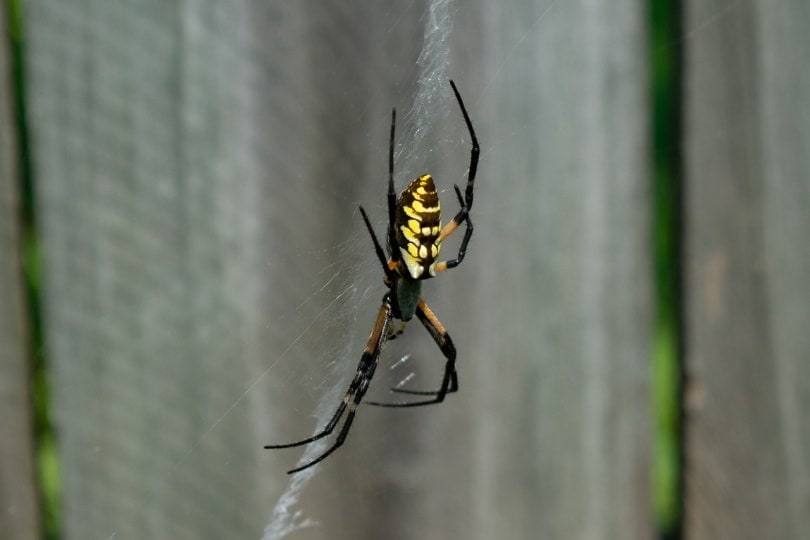Because Kentucky is filled with beautiful mountains and flat pastureland, it is home to around 50 types of spiders. You don’t have to look too hard to find one either. Look around your house, stroll by a field nearby, or go hiking in the east – you will find spiders no matter where you go!
Of course, you need to be careful when looking at Kentucky spiders. There are three poisonous spiders in Kentucky, but the rest are considered less venomous. To learn more about both venomous and less venomous spiders in Kentucky, read on.

The 12 Spiders Found in Kentucky
The 3 Poisonous Spiders Found in Kentucky
Although some states are not home to poisonous spiders, the same cannot be said about Kentucky. Kentucky is home to three highly venomous spiders. This includes the Southern Black Widow, the Northern Black Widow, and the Brown Recluse.
All three of these spider bites will require medical attention. If you seek treatment early enough, the chances of fatality are very low. Still, the bite will be very painful for a few hours or so and you must seek medical attention.
1. Southern Black Widow

| Species: | Latrodectus mactans |
| Longevity: | Females: 3-4 years; Males: 3-4 months |
| Adult size: | 3 – 13 mm |
| Habitat: | Around rodents, rocks, and woodpiles |
| Predators: | Blue Mud Dauber, Wasps, Brown Widow Spiders |
The Southern Black Widow is one of the most known spiders. It is identifiable because it has a sleek black body with red hourglass markings on the abdomen. Sometimes, its spinnerets may look red or orange on females or purple on males.
Female Southern Black Widows are especially venomous, and they have sharper mouthparts that easily penetrate human skin. Although these spiders are venomous, there have been no reports of fatality from their bite.
Though their bites may not be fatal, they certainly are painful and can lead to a number of unwanted side effects, which is why you must seek medical attention.
2. Northern Black Widow
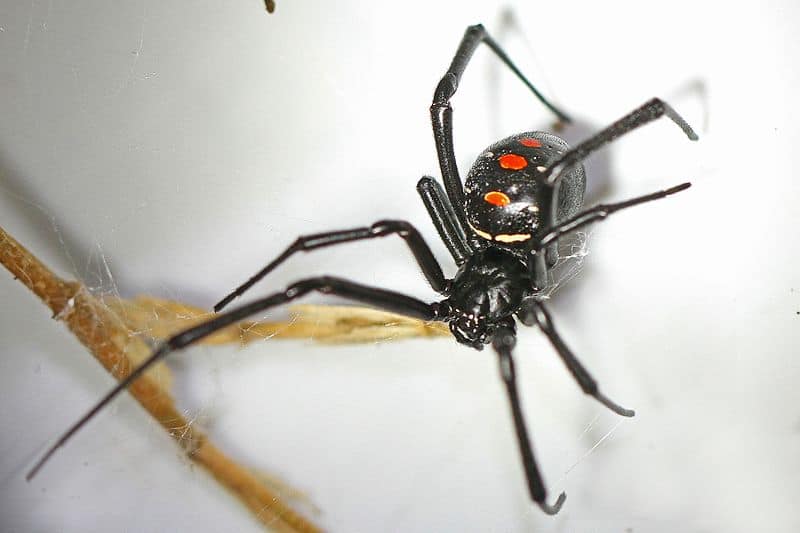
| Species: | Latrodectus variolus |
| Longevity: | 1 – 3 years |
| Adult size: | 4 – 11 mm |
| Habitat: | Undisturbed woods, stone walls, and stumps |
| Predators: | Birds, Spiders |
The Northern Black Widow is similar to the Southern, but it is slightly different. Most notably, the hourglass mark on its abdomen looks slightly different because it is broken. In contrast, the Southern Black Widow has a much more distinct hourglass mark.
Male Northern Black Widows especially look different. They are not black. Instead, they are gray or brown with red spots that make up the broken hourglass. Like Southern Black Widows, the males have a much shorter lifespan since the females eat them after mating.
The bite of the Northern Black Widow isn’t super dangerous. There’s less than a 1% fatality rate, and most of the fatalities reported are from children. Still, seek medical attention if you are bit by a Northern Black Widow.
3. Brown Recluse

| Species: | Loxosceles reclusa |
| Longevity: | ½ to 2 years |
| Adult size: | 7 – 12 mm |
| Habitat: | Dark areas, like a cellar, shed, or garage |
The last poisonous spider found in Kentucky is the Brown Recluse. The Brown Recluse has a dark brown body, but they may have different variations in shade. For example, they may be light brown or so dark that they almost appear black. You can particularly note the Brown Recluse by looking at the violin-shaped pattern on its back.
In comparison to the Black Widows, Brown Recluses are more poisonous, but they are less likely to bite. These spiders are known to be very gentle and only bite if provoked. In the case that you are bit by a Brown Recluse, you need to seek medical attention.

The 9 Less Poisonous Spiders Found in Kentucky
It’s important to note that technically all spiders are venomous. However, most spider venom does not affect humans. Similarly, some spiders are so small that their fangs can’t penetrate human skin in the first place. So, they are essentially non-poisonous. As a result, you don’t have anything to fear from these other spiders.
Let’s take a look at the 9 most common less poisonous spiders found in Kentucky. Keep in mind that this is not a comprehensive list of all of the spiders. These are just the most popular and easiest to find.
4. Banded Garden Spider
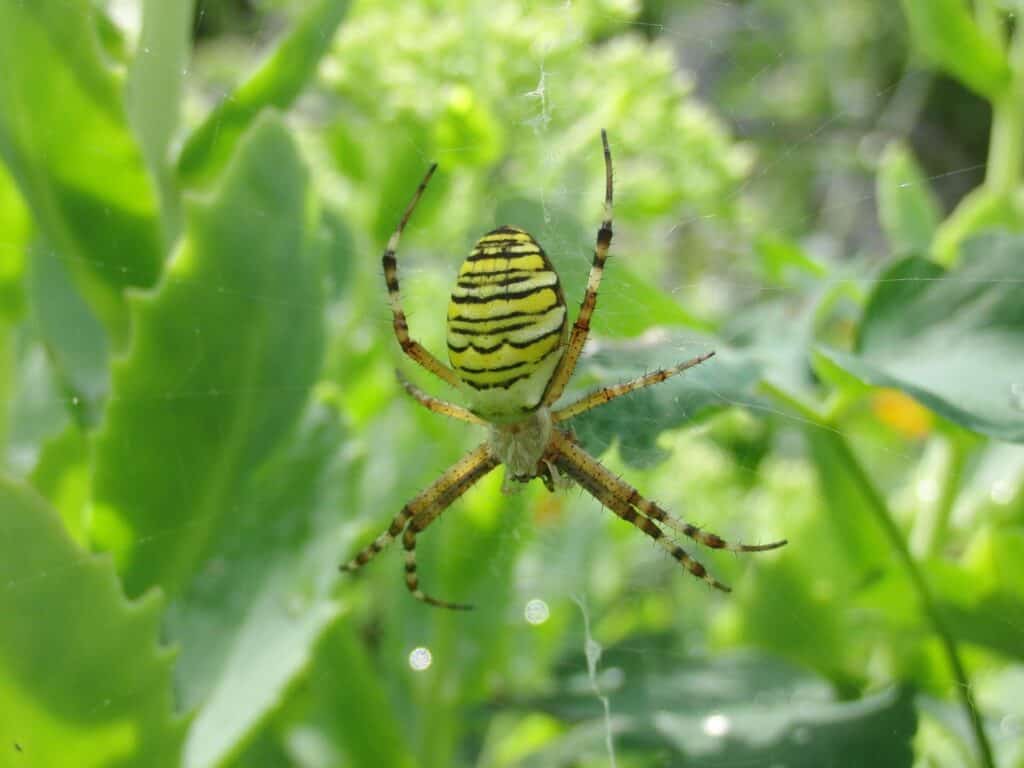
| Species: | Argiope trifasciata |
| Longevity: | 1 year |
| Adult size: | 4 – 14.5 mm |
| Habitat: | Gardens, grasses, shrubs |
| Predators: | Birds, Lizards, Spiders |
Banded Garden Spiders have striking appearances that make them appear more frightening than they actually are. They are covered in silver, black, and yellow rings that make them pop against nearly every background they could be laying on.
These spiders primarily eat wasps and grasshoppers by weaving orb webs. You are most likely to find Banded Garden Spiders outside in dense vegetation, such as gardens, tall grasses, and shrubs.
5. Emerald Jumping Spider
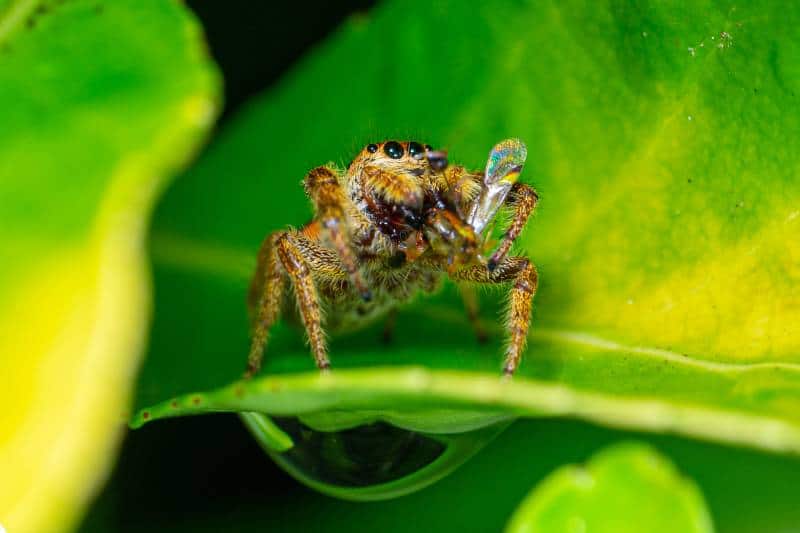
| Species: | Paraphidippus aurantius |
| Longevity: | 1 year |
| Adult size: | Up to 31 mm |
| Habitat: | Forests |
| Predators: | Smaller insects |
The Emerald Jumping Spider is another arachnid that can look a bit scary. These spiders are very hairy and have a black body with white stripes on the head. Its hairiness makes it appear a lot larger than it actually is. You’re most likely to see these spiders hiding out in forests so they can eat their favorite insects.
What’s really unique about the Emerald Jumping Spider is that it can be found in many locations. They can be found in the United States, Panama, and other Caribbean locations. Additionally, Emerald Jumping Spiders are much larger than other Jumping Spiders.
6. Furrow Orb Weaver
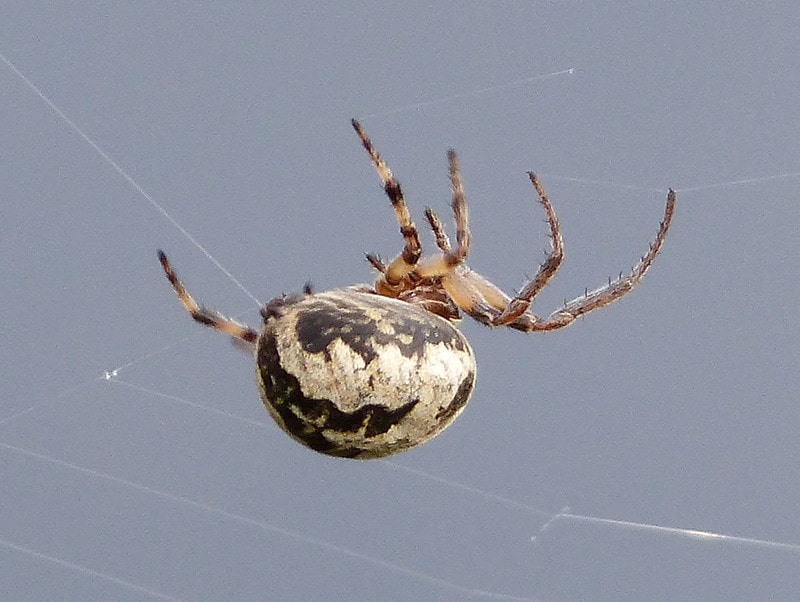
| Species: | Larinioides cornutus |
| Longevity: | 1 year |
| Adult size: | 4 – 14 mm |
| Habitat: | Near bodies of waters or moist areas |
| Predators: | Mud Daubers, Birds |
Furrow Orb Weavers are one of the more common Orb Weaver spiders in the United states. These spiders can come in many color variations, ranging from black to white. What makes them stand out is their oval-shaped and bulbous abdomen. They also have arrow-like patterns on their legs.
Furrow Orb Weaver webs are very unique. They are often built close to the ground by damp vegetation. Every night, the Furrow spider eats the web and makes a new one every evening.
7. Tan Jumping Spider

| Species: | Platycryptus undatus |
| Longevity: | 1 year |
| Adult size: | 8.5 – 13 mm |
| Habitat: | Vertical surfaces |
| Predators: | Birds, Bigger Mammals, Reptiles |
Tan Jumping Spiders are considered one of the most common forms of Jumping Spiders in North America. As a Jumping Spider, the Tan Jumping Spider does not weave webs to catch prey. Instead, it chases and jumps on its prey while shooting out a web just to make sure it catches the food.
Tan Jumping Spiders have compressed bodies that are typically brown, tan, or gray. They may also have some white, black, or red patches, but they primarily blend in with the ground very well. One of the most unique facts about their appearance is that their eyes are positioned so that they have near 360-degree view.
8. Canopy Jumping Spider
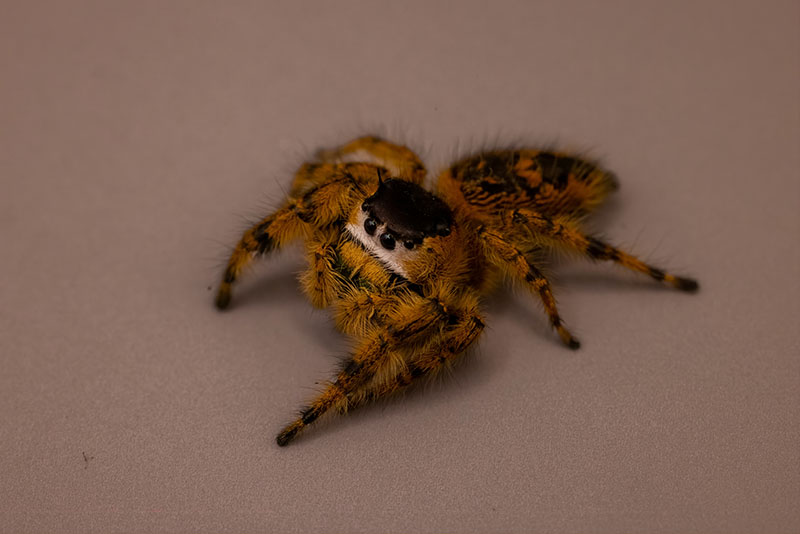
| Species: | Phidippus otiosus |
| Longevity: | 10 – 12 months |
| Adult size: | Up to 16 mm |
| Habitat: | Trees |
| Predators: | Birds, Wasps |
The Canopy Jumping Spider comes in many colors, including brown, white, gray, and orange. They stand out because of their purple or green fangs that are very luminous. They also have super hairy bodies. In fact, the traditional name for this spider is partially from the ancient Greek word “oto,” which means “black tufts of hair.”
You’re most likely to find Canopy Jumping Spiders in the trees. They are harmless to humans and prefer to snack on small insects instead. You can find these spiders all throughout the eastern United States.
9. White Banded Crab Spider
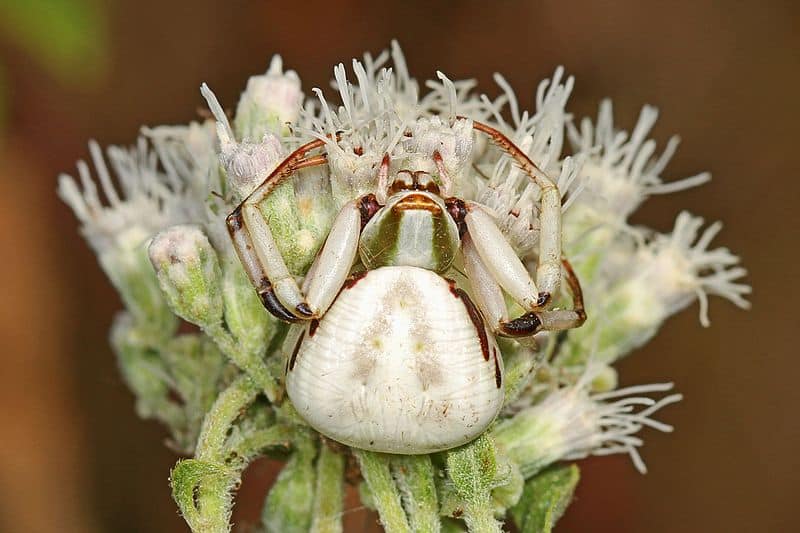
| Species: | Misumenoides formosipes |
| Longevity: | 1 – 3 years |
| Adult size: | 2.5 – 15 mm |
| Habitat: | Flowers and gardens |
| Predators: | Wasps, Birds, and Larger Insects |
If you like to smell flowers whenever you go to a garden or flower shop, you have likely stumbled upon a White Banded Crab Spider before. These spiders have different appearances based on their sex. Females are especially interesting because they can change color based on their surroundings.
The reason you are most likely to find the White Banded Crab Spider around flowers is because they do not make webs to catch their prey. Instead, they hide out on flowers and wait for honey bees, butterflies, and other insects to stop by for some pollen. Then, the spiders pounce on their prey.
10. Southeastern Wandering Spider

| Species: | Anahita punctulata |
| Longevity: | 1 year |
| Adult size: | 7 – 12 mm |
| Habitat: | Burrows in the ground or fruit |
| Predators: | Birds, Larger Insects |
The Southeastern Wandering Spider is another arachnid that looks much more terrifying than it actually is. These spiders typically have a brown or tan body, but some can appear almost as though they are bright red. They also have very long legs, which makes them appear large.
As a Wandering Spider, the Southeastern does not spin webs. Instead, it attacks its prey after hiding out in dens. Even though these spiders are considered less venomous, they are much more aggressive to humans than other spiders. They will become defensive if provoked, but they won’t cause any significant harm.
11. Yellow Garden Spider

| Species: | Argiope aurantia |
| Longevity: | 1 year |
| Adult size: | 5 – 30 mm |
| Habitat: | Tall plants and flowers |
| Predators: | Lizards, Birds, Wasps |
The Yellow Garden Spider is a very striking variety of Orb Weaver. Its abdomen is egg-shaped and has yellow or orange stripes throughout it. Its center is typically black with a few yellow spots. You might be able to find red, orange, or yellow markings at the base as well.
Yellow Garden Spiders tend to be very docile, but they may bite when scared. The venom will not harm, but the bite itself may sting much like a bee sting. Some over the counter medications should be all you need to treat the pain.
12. Tiger Wolf Spider

| Species: | Tigrosa Georgicola |
| Longevity: | 1 year |
| Adult size: | 10 – 21 mm |
| Habitat: | Deciduous forests |
The last common Kentucky spider on our list is the Tiger Wolf Spider. The Tiger Wolf Spider is pretty scary looking simply because it is so large and hairy. Despite its large and intimidating size, it is not considered fatal to humans. The bite itself may sting a bit, but you won’t need to seek medical attention.
Tiger Wolf Spiders tend to be dark brown and have a light brown stripe at the carapace center. Its abdomen also has some light brown marks. Of the spiders on this list, this one is by far the largest, being between 10 and 21 millimeters.

Conclusion
Even though we only covered 12 spiders in this list, Kentucky is home to nearly 50 different types of arachnids. The 12 in this article are the most popular and important to be aware of, such as the three poisonous varieties. Whether you are watching TV at your home or camping in the wilderness, you are likely to stumble upon a spider or two in Kentucky.
You may also want to read:
Featured Image Credit: Frank DiLorenzo, Pixabay
